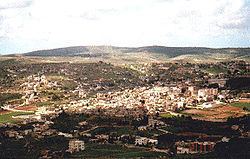Area 9.1 km² Local time Thursday 6:04 AM | Population 30,000 (2001) | |
 | ||
Weather 8°C, Wind S at 5 km/h, 84% Humidity | ||
Revisiting southern lebanon bint jbeil
Bint Jbeil (Arabic: بنت جبيل) is the second largest town in the Nabatiye Governorate in Southern Lebanon.
Contents
- Revisiting southern lebanon bint jbeil
- Map of Bint Jbeil Lebanon
- Bint jbeil war s lasting damage
- History
- Ottoman era
- Modern era
- Notable people
- News articles
- References
Map of Bint Jbeil, Lebanon
The town has an estimated population of 30,000. Its exact population is unknown, because Lebanon has not conducted a population census since 1932.
Bint jbeil war s lasting damage
History
The area around Bint Jbeil has been inhabited for millennia. Archaeologists have suggested that the ancient fortified city of En-hazor.
According to some historians, the name of the town is derived from a Yemeni name. They argue that the name is linked to Yemeni tribes that immigrated to the Levant centuries ago from Yemeni towns such as Jibla, Jabalan Al Ardaba, and Jabalan Al Raymah, or the two territories of the Jubail lowland and Jubail highland. Other historians claim that the founders of Bint Jbeil were the Phoenicians, who came from the northern Lebanese town of Jbeil (Byblos); they may have been Shia Muslims escaping the Mamluk occupation of Byblos. Bint Jbeil literally means "daughter of Byblos".
According to E. H. Palmer, the name means "The daughter of the mother of the little mountain".
Ottoman era
In 1596, it was named as a village, ‘’Bint Jubayl’’ in the Ottoman nahiya (subdistrict) of Tibnin under the liwa' (district) of Safad, with a population of 238 households and 60 bachelors, all Muslim. The villagers paid taxes on agricultural products, such as wheat, barley, olive trees, fruit trees, goats and beehives, in addition to "occasional revenues”, a press for olive oil or grape syrup, and a fixed sum; a total of 25,220 akçe.
In 1838 Edward Robinson noted it as a large Shia village, while in 1875, Victor Guérin found it to be a village with one thousand Metualis.
In 1881, the Palestine Exploration Fund's Survey of Western Palestine (SWP) described it: "A very large Metawileh village, containing about 1,100 to 1,500 Metawileh. A market is held here every Thursday. The village is well built, and has a mosque. The situation is surrounded by higher hills, though the village is on high ground. The cultivation around is grapes, olives, and arable land. Water is supplied from a spring and many cisterns and large birket."
Modern era
The town is predominately inhabited by Shia Muslims (90%), though the surrounding area also has a significant Christian (10%) minority.
Bint Jbeil was occupied by Israel in 1978 during Operation Litani, and again from 1982 until 2000 during the 1982-2000 South Lebanon conflict, when it was severely depopulated; as much as 75% of the population was reported to have left for other parts of Lebanon. It was the scene of occasional attacks on Israeli occupation forces, such as a car bombing carried out by a Hezbollah member on 25 April 1995. Hezbollah took control of the town following the Israeli withdrawal from South Lebanon.
As the largest town in the area, Bint Jbeil is sometimes known as the "Capital of the Liberated South" (among Lebanese Shi'ites). It is considered one of the centers with symbolic history for Hezbollah. Under Lebanon's complicated system of sectarian electoral representation, the Bint Jbeil electoral district is allocated 3 Shi'ite seats in the country's parliament. Hezbollah did well in the area in the 2005 elections in Lebanon, winning the local seats to add to its nationwide tally of 14.
Bint Jbeil was again contested by Israeli and Hezbollah forces in the 2006 Israel-Lebanon conflict, during which it suffered heavy damage (See Battle of Bint Jbeil). On July 15, Israeli missile killed 4 civilians, aged between 60 and 85.
Reconstruction as of early 2007 had been going very slowly, leading to reports of dissatisfaction among the residents. Iranian President Mahmoud Ahmadinejad visited the town in 2010 to show solidarity for Hezbollah and the local victims of Israel's attacks.
